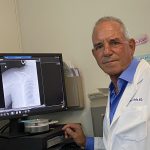Experts weigh in on sustaining telerheumatology as a viable practice tool by sharing its history, potential and regulatory outlook post-pandemic at ACR Convergence 2020.
Search results for: health insurance

Guidance Coming for Anticipated COVID-19 Vaccine
What to vaccinate for and when to do so are challenges for rheumatologists and rheumatology professionals under normal circumstances. During the COVID-19 pandemic, even more questions are being raised, specifically regarding a possible vaccine for SARS-CoV-2. The ACR’s COVID-19 Practice and Advocacy Task Force is working on a guidance document to help ACR members address these pressing questions.

Advocacy 101 Teaches Legislative, Advocacy Basics
Bharat Kumar, MD, Advocacy 101 coordinator and Government Affairs Committee member, describes the virtual program designed to educate and empower rheumatology fellows in training, program directors and ARP members to advocate for issues that affect rheumatology practices and patients in advance of the Advocates for Arthritis that will take place virtually in September.

Talk It Up! 5th Annual Rheumatic Disease Awareness Month
This September marks the ACR’s fifth annual Rheumatic Disease Awareness Month (RDAM), which is designed to build support and advocate for patients with rheumatic diseases. This year’s theme, “My disease may be invisible, but I’m not,” emphasizes patients’ personal experiences…
ACR Leaders Discuss Hydroxychloroquine Issues with FDA Commissioner
The conversation with Stephen Hahn, MD, addressed challenges associated with hydroxychloroquine access during the COVID-19 public health emergency and handling patient concerns about potential cardiac side effects.
Denosumab Dosing Delays Tied to Increased Fracture Risk
NEW YORK (Reuters Health)—Denosumab injection delays of more than four months are associated with an increased risk of fracture compared with on-time injections, especially at the spine, new research indicates. “This study suggests the importance of timely denosumab administration when used for long-term osteoporosis management,” the researchers write in Annals of Internal Medicine.1 “When starting…

Financial Impacts of COVID-19 on Practices: Q&A with Norman Gaylis, MD
Community rheumatology practices are confronting a significant financial fallout from stay-at-home orders and fears that keep patients at home, as well as reimbursement challenges.
COVID-19: Practical Tips for Practices
The ACR’s July 13 online town hall, “COVID-19 Guidance for Community Practices,” covered telehealth, safe clinic reopening and Department of Health & Human Services loans.

Incorporating Rheumatology Nurses into Training
At the Johns Hopkins School of Medicine Division of Rheumatology, Baltimore, registered nurses (RNs) are an integral aspect of the rheumatology fellowship program. This gives the fellows information and insight into areas of practice they might not otherwise receive. “This [practice] is a result of our very strong belief that an integrated and interdisciplinary approach,…

Telemedicine & Fellowship Education After COVID-19: Q&A with Kanika Monga, MD
The COVID-19 pandemic is reshaping clinical rheumatology and the fellowship experience. Rheumatology education should include how to triage patients for remote visits, says second-year fellow Kanika Monga, MD…
- « Previous Page
- 1
- …
- 66
- 67
- 68
- 69
- 70
- …
- 115
- Next Page »